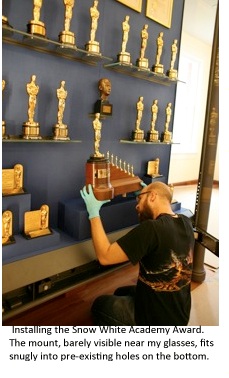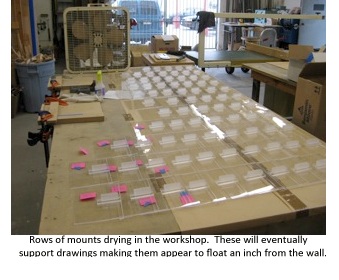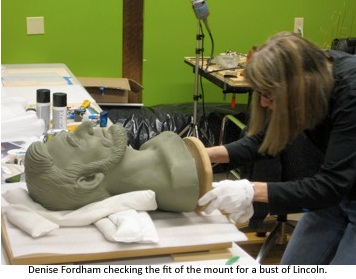This is the last of a five-part series that looks back at the Museum's roots and its journey to opening day, Oct. 1st, 2009.
 If mountmakers, installers, preparators, art handlers (we have lots of different names) do their job well you will never know they exist. We might spend hours, days, months, even years preparing and installing an exhibit but when you, the visitor, come to see it we don’t want you thinking anything about the work we do. Our charge is to get the artifacts into the cases in a safe and secure manner so that they can be seen by you and tell the stories they want to tell now and 50 years from now.
If mountmakers, installers, preparators, art handlers (we have lots of different names) do their job well you will never know they exist. We might spend hours, days, months, even years preparing and installing an exhibit but when you, the visitor, come to see it we don’t want you thinking anything about the work we do. Our charge is to get the artifacts into the cases in a safe and secure manner so that they can be seen by you and tell the stories they want to tell now and 50 years from now.
For the opening of The Walt Disney Family Museum this meant preparing and installing over 1500 amazing but often fragile artifacts from the collection of The Walt Disney Family Foundation and various lenders. Working closely with the staff of the Foundation and led by Denise Fordham of Fordham & Associates the team that took on this huge endeavor consisted of Gina Borg, Neil Stewart and me.
Working with designers and curators we determined not only where each object was going to be placed but how it would be positioned in that place; would it sit squarely on the case deck, would it appear to float in front of the wall, would it be tilted backward or forward to better highlight a particular feature?
Besides making an object look good, our main task is ensuring an artifact’s safety, especially here in earthquake country. We want to be sure that if we do get a shake, drawings will not fall off walls and fragile character model statues will not bump into each other and crumble into sad little pieces. The trickiest part is that we need to do all this in such a manner that you don’t even realize it is happening. Artifact supports need to disappear. If we can’t hide them we at least want them to be as unobtrusive as possible. We don’t want you thinking about how the artifact is supported -- we want you concentrating on the artifact itself.
 After a few years of doing this type of work, one day my dad teased me that I had ruined museum exhibits for him. By this time he had heard lots of stories about what I do and I had toured him through a number of exhibits explaining how we had supported certain artifacts. He told me that now when he would go to museums he would spend more time trying to decipher how artifacts were secured than actually looking at the artifacts themselves. He would squeeze behind cases to see how an African mask floated in mid air. He would kneel down to see what was holding the Greek statue on its pedestal. I don’t want to ruin any exhibits for you but I will share some of our secrets anyways. Here are some examples:
After a few years of doing this type of work, one day my dad teased me that I had ruined museum exhibits for him. By this time he had heard lots of stories about what I do and I had toured him through a number of exhibits explaining how we had supported certain artifacts. He told me that now when he would go to museums he would spend more time trying to decipher how artifacts were secured than actually looking at the artifacts themselves. He would squeeze behind cases to see how an African mask floated in mid air. He would kneel down to see what was holding the Greek statue on its pedestal. I don’t want to ruin any exhibits for you but I will share some of our secrets anyways. Here are some examples:
For a bust of Lincoln (from the case about Great Moments with Mr. Lincoln) Neil carefully carved a dense foam to the exact shape of the bust’s interior. This support was secured to the pedestal on which the bust sits (and the pedestal is secured to the bottom of the case) ensuring that Lincoln will never tip over and you will never see the foam. There was no inner cavity where we could hide the metal support needed to make sure Hyacinth, the hippo from Fantasia, was not going to dance away and break in an earthquake. So we made the support as small as possible and Gina, the master color matcher, painted it the same color as the statue. To make all the drawings in our Silly Symphonies case float 3 inches from the wall Denise designed a complex metal and plastic support that not only achieved the desired effect, but was also adjustable so when it came to installing the case and trying to get all 41 drawings to line up just right, we could raise one a little bit, lower another just a tad, or move the next one to the right or left.

To do this type of work for over 1500 artifacts takes a great deal of time and energy but we know it is worth it when, strolling through the galleries, no one thinks about how these objects are kept in place but just sees drawings of dwarfs, hippos dancing on the decks and all sorts of other artifacts that are there to tell the story of Walt Disney.
